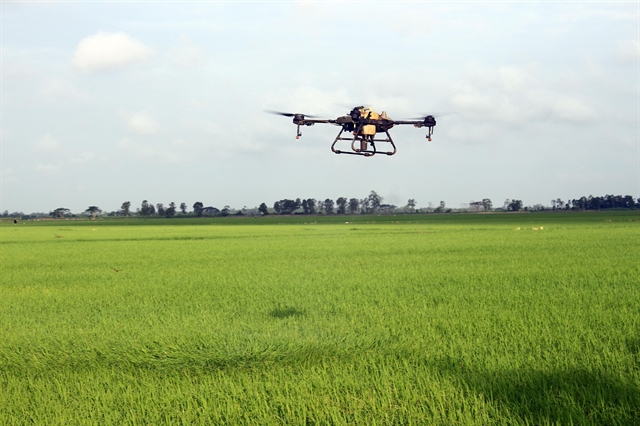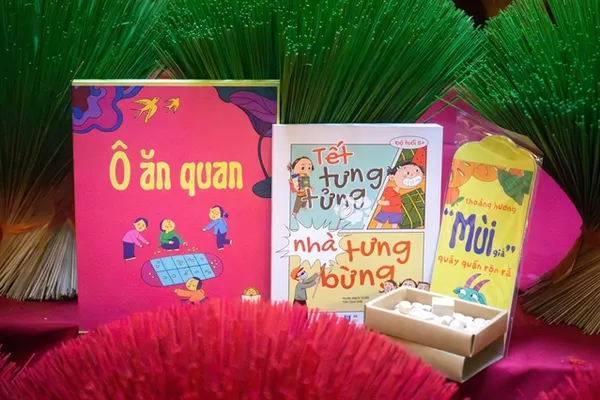 Society
Society

 |
| A drone is used to spray pesticides on rice fields in Sóc Trăng Province’s Long Phú District. – VNA/VNS Photo Tuấn Phi |
SÓC TRĂNG – Sóc Trăng Province is increasingly developing green, clean and effective farming models to improve farmers’ incomes.
They include growing lotus in rice fields, water lily in ponds and environment-friendly rice farming.
Nguyễn Văn Mỹ in Mỹ Tú District’s Mỹ Thuận Commune has switched from rice to lotus in his three-hectare field and now earns VNĐ3-5 million (US$120-205) a day from selling the flowers.
Mỹ also breeds fish in the lotus field and earns dozens of millions of đồng a year from it.
Lotus provided higher profits than rice, he said.
The Cửu Long (Mekong) Delta province has favourable conditions in terms of soil, water and human resources for diversifying agriculture and farming on a large scale.
It has more than 280,000ha of farmland, or 84.7 per cent of its total area.
More and more farmers there are using advanced techniques to improve quality, yield and value.
Nguyễn Hữu Công in Long Phú District’s Song Phụng Commune has created a new sweet passion fruit variety and applied advanced farming techniques to grow the fruit.
He uses an automatic irrigation system, and since he meets Vietnamese good agricultural practices (VietGAP) standards, his fruit fetches high prices and has steady demand in Sóc Trăng and elsewhere.
He has registered a brand name for the fruit, “Sáu Công-Sóc Trăng sweet passion fruit.”
He hires around 65 workers to make various products from the fruit and earn a profit of VNĐ2.7 billion ($112,000) a year.
He was recognised as one of 100 outstanding farmers by the Việt Nam Farmers Association this year.
The province Farmers Association has organised many programmes and events to encourage farmers to work together to mitigate poverty.
The number of farming households with an income of more than VNĐ450 million ($19,000) a year has increased by 2.5 times from five years ago, according to the association.
The province has identified seafood and rice as key products and fruits as potential items for exporting, its Department of Agriculture and Rural Development said.
It produced more than two million tonnes of paddy in the first nine months of the year, including 1.9 million tonnes of high-quality and specialty varieties.
Huỳnh Ngọc Nhã, director of the department, said farmers were instructed to use advanced techniques for growing rice to reduce costs, improve quality and yield, and increase profits.
The department assisted them in getting production codes for key crops to meet export requirements, he said.
The province has nearly 29,000ha of fruits, including 13,439ha grown using organic methods.
The key fruits are banana, mango, milk apple, longan, and various citrus varieties.
The province has 94 fruit growing areas with more than 582ha that have been granted production codes.
The department helped co-operatives sign farm contracts with companies to guarantee outlets for 870 tonnes of fruits in the first nine months of this year, including 291 tonnes for exports, Nhã said.
During the period the province farmed aquatic species on 67,231ha of ponds and harvested 232,000 tonnes, up nearly 9 per cent year-on-year, he said.
The department planned to help co-operatives and co-operative groups breed aquatic species to quality standards such as VietGAP, GlobalGAP, Global Aquaculture Stewardship Council, and Best Aquaculture Practices.
It would link up farmers and companies.
It would advocate effective aquatic breeding models such as two-stage shrimp farming.
The two-stage shrimp farming model uses multiple ponds for breeding shrimp and treating wastewater. Breeding ponds are installed with oxygenation equipment, anti-sunlight nets and plastic sheets on their beds.
The province’s seafood exports, mostly of shrimp, topped $1 billion last year. – VNS




